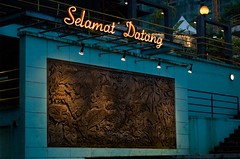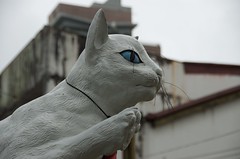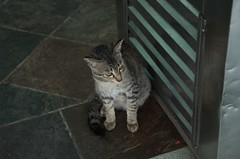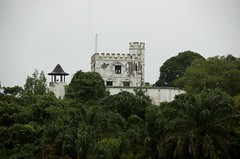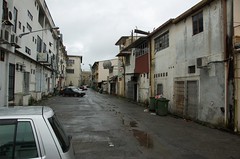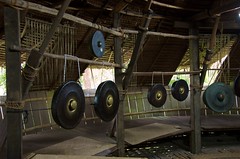 The Sarawak Cultural Village is located at the Pantai Damai (Damai Beach) resort area, about 40 minutes’ drive from the city of Kuching. The village contains examples of the types of houses that are characteristic of those built by the ethnic groups that inhabit Sarawak. Upon entry to the village, visitors are given a “Village Passport” which contains information about the local people. This passport has a section in which tourists can collect stamps from each of the village houses that they visit.
The Sarawak Cultural Village is located at the Pantai Damai (Damai Beach) resort area, about 40 minutes’ drive from the city of Kuching. The village contains examples of the types of houses that are characteristic of those built by the ethnic groups that inhabit Sarawak. Upon entry to the village, visitors are given a “Village Passport” which contains information about the local people. This passport has a section in which tourists can collect stamps from each of the village houses that they visit.A map of the Sarawak Cultural Village and Damai Beach
View Larger Map
The current population of Sarawak consists mainly of the indigenous Iban people, and immigrant Chinese and Malays. The Iban traditionally lived in groups in the lowlands, in longhouses that were built to last around twenty years. Although they were farmers, the Iban gained notoriety among early European travelers as head-hunters. In some social groups, Iban men were not considered worthy for marriage until they had brought home the head of an enemy from battle. The descendants of the Iban account for around 30% of the current population of Sarawak.

 Longhouses were a kind of miniature “village within a house”. Limited privacy was afforded by segmenting the longhouse into rooms that were used for different activities. The effort expended in constructing the longhouse could thus be shared by all of the people that would inhabit it. In particular, providing shelter from the rains of Borneo would have been a great incentive for cooperation in the construction of the common roof.
Longhouses were a kind of miniature “village within a house”. Limited privacy was afforded by segmenting the longhouse into rooms that were used for different activities. The effort expended in constructing the longhouse could thus be shared by all of the people that would inhabit it. In particular, providing shelter from the rains of Borneo would have been a great incentive for cooperation in the construction of the common roof. In more mountainous regions, another ethnic group, the Bidayuh, also traditionally lived in longhouses. The Bidayuh consist of several sub-groups; namely the Jagoi, Biatah, Bukar-Sadong, Selakau and Lara peoples. The Bidayuh were often more gentle than the Iban, although they still collected the heads of their enemy in battle and hung them to smoke above the fire. Among their technological achievements, the Bidayuh invented indoor plumbing! The mountainous terrain on which they lived allowed them to dam rivers up-stream from their houses and use a gravity-fed system of bamboo conduits to supply water. The Bidayuh account for around 8.4% of the current Sarawak population.
In more mountainous regions, another ethnic group, the Bidayuh, also traditionally lived in longhouses. The Bidayuh consist of several sub-groups; namely the Jagoi, Biatah, Bukar-Sadong, Selakau and Lara peoples. The Bidayuh were often more gentle than the Iban, although they still collected the heads of their enemy in battle and hung them to smoke above the fire. Among their technological achievements, the Bidayuh invented indoor plumbing! The mountainous terrain on which they lived allowed them to dam rivers up-stream from their houses and use a gravity-fed system of bamboo conduits to supply water. The Bidayuh account for around 8.4% of the current Sarawak population. The Melanau people built large houses in coastal regions that were supported about 12 m above the ground. They preferentially ate Sago palms, instead of the rice that was usually eaten by most of the other ethnic groups. The remaining indigenous people are often categorized under a single name: the Orang Ulu, which means “up-river dwellers”. The Orang Ulu comprise the Penan, Kayan, Kenyah, Kelabit and Lun Bawang. Among these groups, the Penan, who live in the dense jungles of Central Borneo, are often noted for their use of blowpipes in hunting.
The Melanau people built large houses in coastal regions that were supported about 12 m above the ground. They preferentially ate Sago palms, instead of the rice that was usually eaten by most of the other ethnic groups. The remaining indigenous people are often categorized under a single name: the Orang Ulu, which means “up-river dwellers”. The Orang Ulu comprise the Penan, Kayan, Kenyah, Kelabit and Lun Bawang. Among these groups, the Penan, who live in the dense jungles of Central Borneo, are often noted for their use of blowpipes in hunting.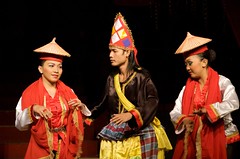 The Cultural Village has an auditorium, at which dance performances are held twice each day. These dances are quite varied and show off the spectacular traditional dress of each of the ethnic groups. Having done some jungle trekking, I often had pause to wonder whether the long, elaborate traditional costumes were worn during daily life or only for special celebrations. Unfortunately, I never had that particular question answered. We visited in the late monsoon season, and the wet weather had apparently scared away most tourists from the village. The houses themselves were quite empty for most of our visit, with the exception of the very friendly Bidayuh longhouse, at which we were warmly welcomed.
The Cultural Village has an auditorium, at which dance performances are held twice each day. These dances are quite varied and show off the spectacular traditional dress of each of the ethnic groups. Having done some jungle trekking, I often had pause to wonder whether the long, elaborate traditional costumes were worn during daily life or only for special celebrations. Unfortunately, I never had that particular question answered. We visited in the late monsoon season, and the wet weather had apparently scared away most tourists from the village. The houses themselves were quite empty for most of our visit, with the exception of the very friendly Bidayuh longhouse, at which we were warmly welcomed.My impression was that the Cultural Village was very much set up to cater to tourists. I think that it represented a good attempt to convey a superficial sense of the culture of the region, but that it was lacking depth in some areas. Aside from the village passport and some posters which were hung in each of the houses, there was little educational material available.
European culture was forced upon Sarawak by James Brooke, an unsuccessful trader, who arrived there in August 1838 after inheriting a sum of £30,000. When he arrived, a Bidayuh uprising was in progress against the Sultan of Brunei, who ruled Sarawak at that time. He helped to induce a peaceful settlement to the uprising and was granted the title of Rajah by the Sultan; thus becoming the first White Rajah.
Don't forget that more pictures of my journey are available online at my Flickr Photostream: http://www.flickr.com/photos/28808691@N05/
